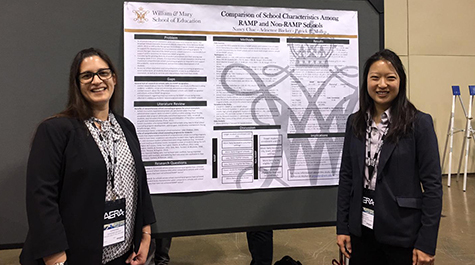W&M students and faculty participate in AERA conference
William & Mary School of Education faculty and students headed north in early April, crossing the border to Toronto, Canada to attend this year’s American Educational Research Association’s (AERA) annual conference. With an estimated 14,000 attendees, it is considered the largest gathering of educational research scholars. This year’s theme, Leveraging Education Research in a Post-Truth Era: Multimodal Narratives to Democratize Evidence, looked at making connections across research to strengthen findings at time when opinions seem to matter more than facts.
A number of research papers from faculty and students were accepted into the conference and one team of researchers received the 2019 American Educational Research Association Distinguished paper award for their work evaluating the validity and reliability of an evaluation instrument used by the School of Education to evaluate student teachers.
The team included Tom Ward, professor of research methods; Chris Gareis, professor of curriculum development; Jake Joseph, manager of assessment and accreditation; and second year doctoral student Sarah Hylton.
"This work is a good example of how School of Education students and faculty are collaborating on professional preparation and the translation of research into action," says Ward. "The paper uses actual data from our assessments to inform us about our instruments, process, and, ultimately, our programs. An added benefit is that the results were shared with other professionals across the country."
"We wanted to know if the tool was valid and reliable. The instrument has 30 competencies currently divided into six different domains. What we discovered is that the users see those 30 grouping more into four factors: planning, onstage teaching, assessment and professionalism," says Hylton. Confirmatory factor analysis and structural equation modeling were two of the methodologies used by the team. According to Hylton, they are planning to submit the results for publication.
A number of students and faculty members presented research at the conference; below is a quick look at a few:
Comparison of School Characteristics Among RAMP and Non-RAMP Schools
Adrienne Backer and Nancy Chae, both doctoral students in counselor education, presented their work with Assistant Professor Patrick Mullen, comparing the characteristics of schools that earned the Recognized American School Counselor Association Model Program (RAMP) designation with a random sample of schools without this designation using data from the Department of Education. They found that non-RAMP schools were more likely to be eligible for Title I; had higher rates of students eligible for free or reduced lunch; were located in city, rural, and township communities; and had fewer students and full-time equivalent employees. Further research is needed to evaluate the effectiveness of the program as an evidence-based practice. Some suggested implications to be considered included increasing access to the program through support, incentives and advocacy.
This is the second year Chae has attend the conference; last year, she received a fellowship. Following in her footsteps, Backer was selected as a recipient of this year’s Division E Graduate Student Fellowship, focusing on counseling and human development.
An Integrative Literature Review of Contemporary Connected Learning Research
Katalin Wargo, a doctoral student in the Curriculum and Learning Design program, presented research on a co-authored paper that identified the ways educators, researchers, and designers have utilized connected learning, a method of learning that encourages pursuit of personal interests over standardization, resulting in academic success and life accomplishments. Their review included looking at how connected learning has lived up to (or not) the equity ideals of its formulators, how it has surprisingly spread across fields, which parts of the connected learning design framework have been implemented and which have been ignored, and how researchers have developed new methodological approaches to studying connected learning. This analysis was a continuation of their earlier research into why connected learning has spread so rapidly and into which contexts as well as how it is being implemented.
